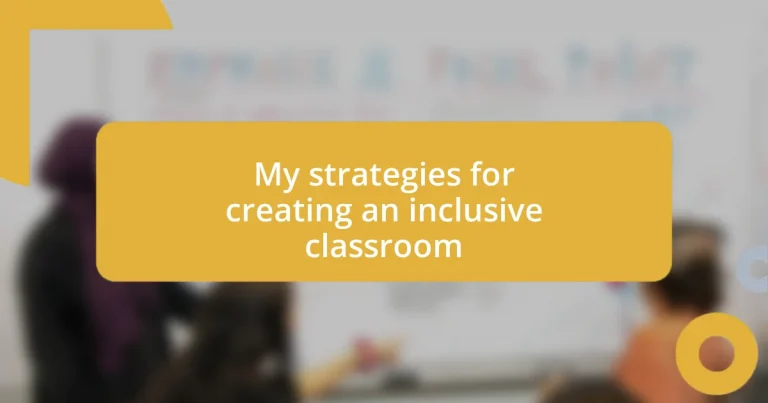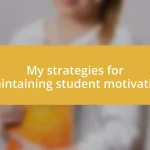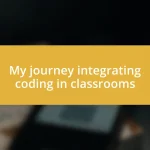Key takeaways:
- Inclusive education values diversity and requires recognizing individual learning needs, as demonstrated by using different formats like audiobooks or visual aids to cater to various learning styles.
- Implementing Universal Design for Learning (UDL) enhances student engagement and motivation by offering flexible assignment options and creating an environment conducive to collaboration and creativity.
- Engaging families and communities significantly enriches the educational experience by fostering connections, encouraging open communication, and making students feel valued within a supportive learning environment.
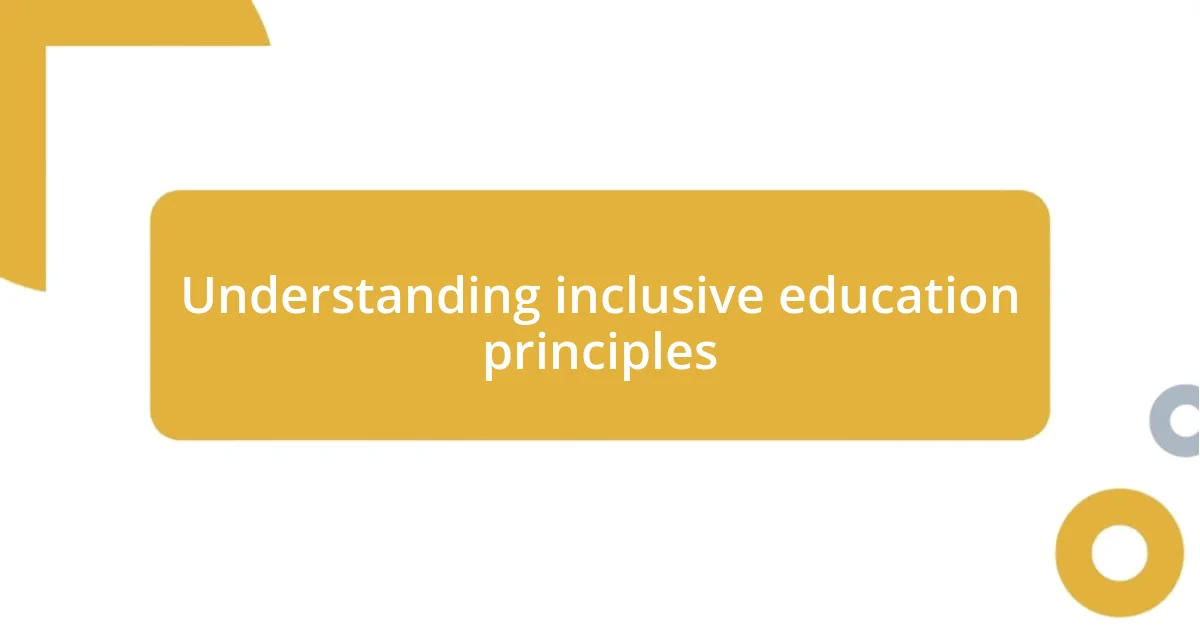
Understanding inclusive education principles
Inclusive education hinges on the principle that every student’s learning needs must be acknowledged and met. I remember the first time I saw a shy student with a hearing impairment truly engage during a lesson when we used visual aids and sign language support. It made me wonder—how often do we overlook simple adjustments that can make a world of difference in a child’s educational experience?
At its core, inclusive education is about valuing diversity. Each student brings unique strengths and experiences to the classroom, shaping the collective learning environment. I often reflect on a time when a student with autism shared his passion for drawing during project presentations; his enthusiasm inspired others and illuminated the idea that inclusion isn’t just about academic adjustments but fostering an atmosphere where every voice is heard.
Moreover, embracing inclusive education means understanding that barriers often extend beyond the classroom. For instance, when I collaborated with parents to create a support plan, it struck me how vital those home-school connections are. Have you ever considered how a student’s home life can impact their classroom experience? This awareness has significantly influenced my approach, helping me strive for a holistic understanding of each child’s needs.
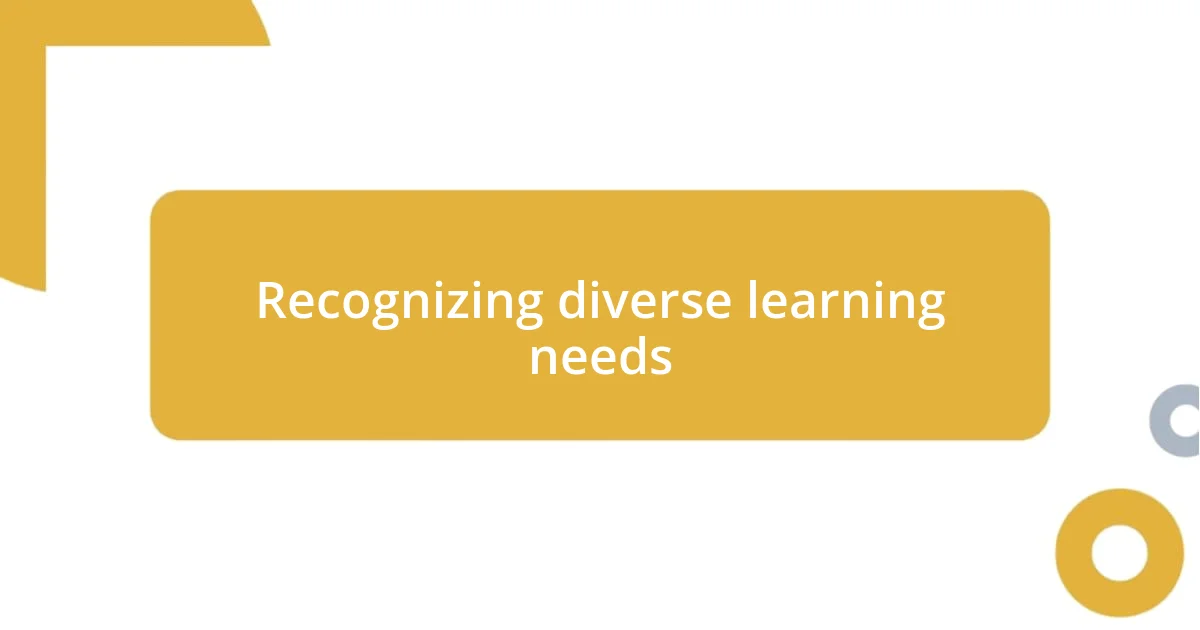
Recognizing diverse learning needs
Recognizing the diverse learning needs of students is essential for creating an inclusive classroom. I recall a time when a student who struggled with reading was given the option to use audiobooks instead of traditional texts. The spark in her eyes as she followed along with the audio was incredibly rewarding. It reminded me that sometimes, all it takes is one simple change to unlock a student’s potential.
Each learner is unique, bringing different backgrounds and learning styles to the table. For instance, I had a student for whom verbal instructions were overwhelming. By incorporating more visual aids and hands-on activities, I noticed a shift; she began to thrive and express her creativity in ways I never imagined. Isn’t it amazing how tailoring our approaches can transform a student’s experience?
Furthermore, it’s crucial to seek feedback from the students themselves. I remember conducting a brief survey asking how my students preferred to learn. The responses were enlightening! Some wanted more group work, while others preferred solitary tasks. Engaging students in these conversations not only helps recognize their individual learning needs but also empowers them to take ownership of their educational journey.
| Learning Style | Example Adaptations |
|---|---|
| Visual | Use of charts, images, videos |
| Auditory | Audiobooks, podcasts, group discussions |
| Kinesthetic | Hands-on activities, role play |
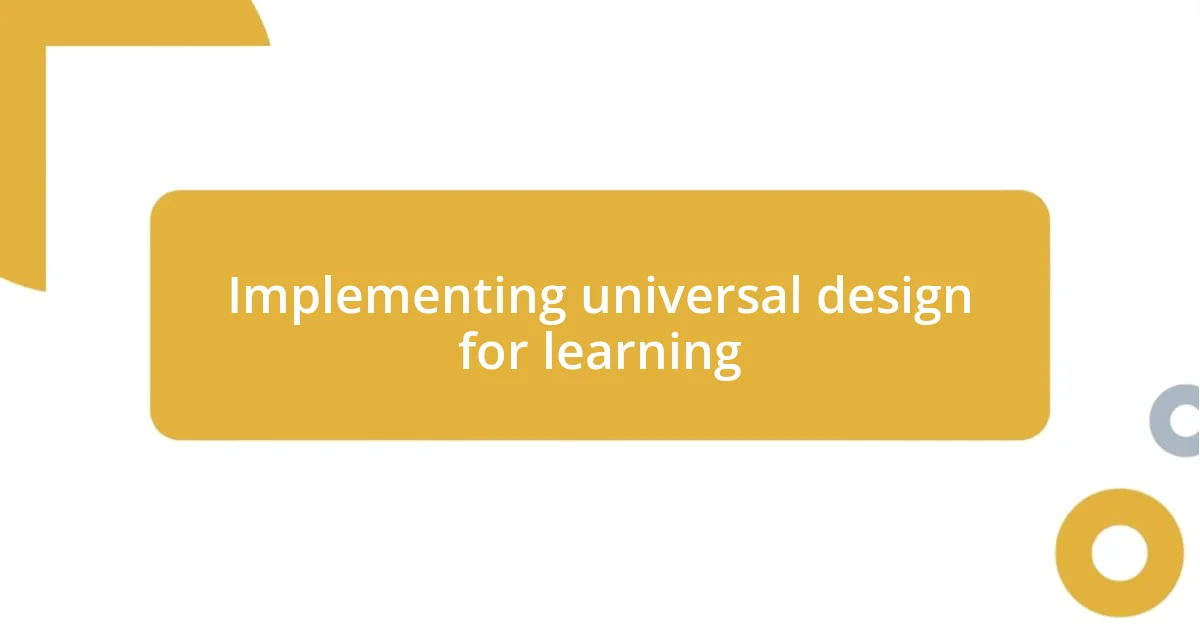
Implementing universal design for learning
Implementing universal design for learning (UDL) is a powerful way to create inclusive classrooms where every student feels valued and capable of learning. From my experience, incorporating multiple means of engagement makes a significant difference. For instance, I once introduced flexible assignment options that allowed students to choose how they would demonstrate their understanding, whether through a presentation, an art project, or a traditional essay. The excitement in the room was palpable as students selected tasks that aligned with their interests and strengths— it was a vivid reminder that providing choices can motivate and empower learners.
To better implement UDL, I like to focus on the following strategies:
- Multiple Means of Representation: Use varied formats to present information, such as videos, charts, and hands-on experiments to cater to different learning preferences.
- Flexible Learning Environments: Create spaces where students can work collaboratively or independently, allowing them to choose the setting that suits them best.
- Continuous Feedback Loops: Regular check-ins with students provide insights into their learning processes, enabling adjustments to better meet their needs.
My heart swells every time I see a student embrace their chosen method of expression. Just last semester, a typically reserved student astounded me with a digital comic strip to summarize her understanding of a complex topic. Her pride was written all over her face, and moments like these fuel my belief in the transformative power of UDL.
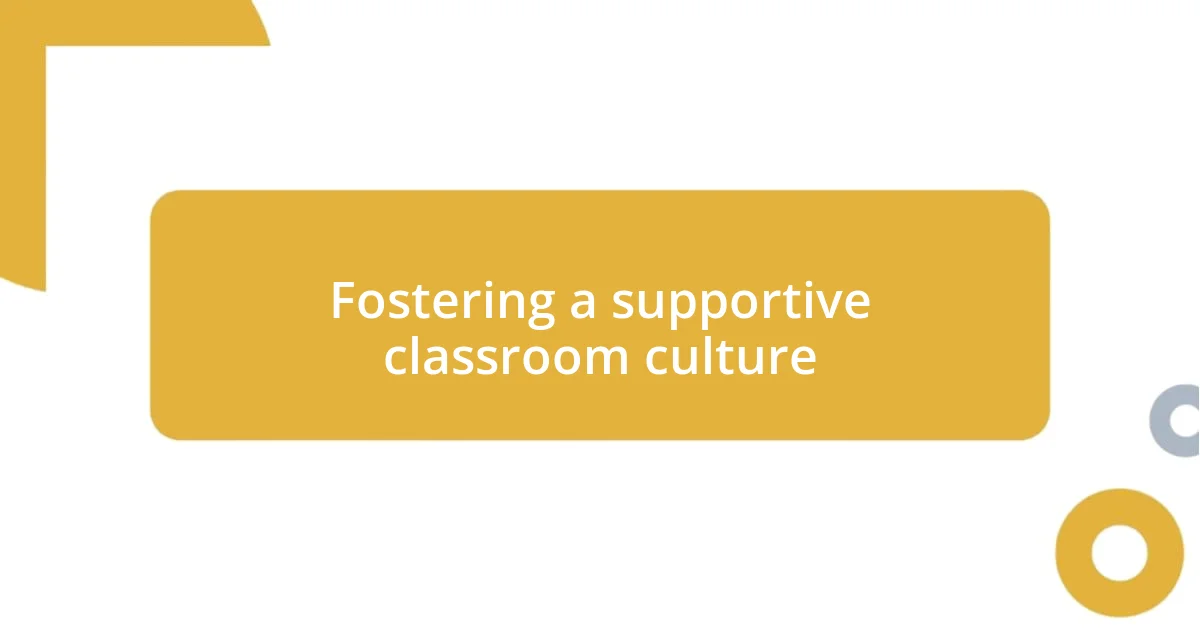
Fostering a supportive classroom culture
Creating a supportive classroom culture means cultivating an environment where every student feels they belong. I think about a time when I set aside the first few minutes of class for a share-out time, where students could talk about something meaningful to them. It was incredible how quickly they opened up! Not only did I learn about their interests, but fellow students discovered common ground, fostering friendships I hadn’t anticipated.
Another approach I’ve adopted is celebrating small successes. After a difficult unit, I once hosted a “brag board” where students could post one achievement, no matter how minor it seemed to them. Watching them beam with pride as they pointed to their contributions taught me something vital: sometimes, recognition is all it takes to support students emotionally. Wouldn’t you agree that such small gestures can have a ripple effect on a student’s confidence?
I also believe in the power of peer support. In a recent class project, I paired students strategically to mix various skill levels. The way the more advanced students articulated concepts and helped their peers was rewarding. It created a shared sense of community that emphasized we’re all in this together. Isn’t it heartwarming to see students lift each other up in their learning journeys?
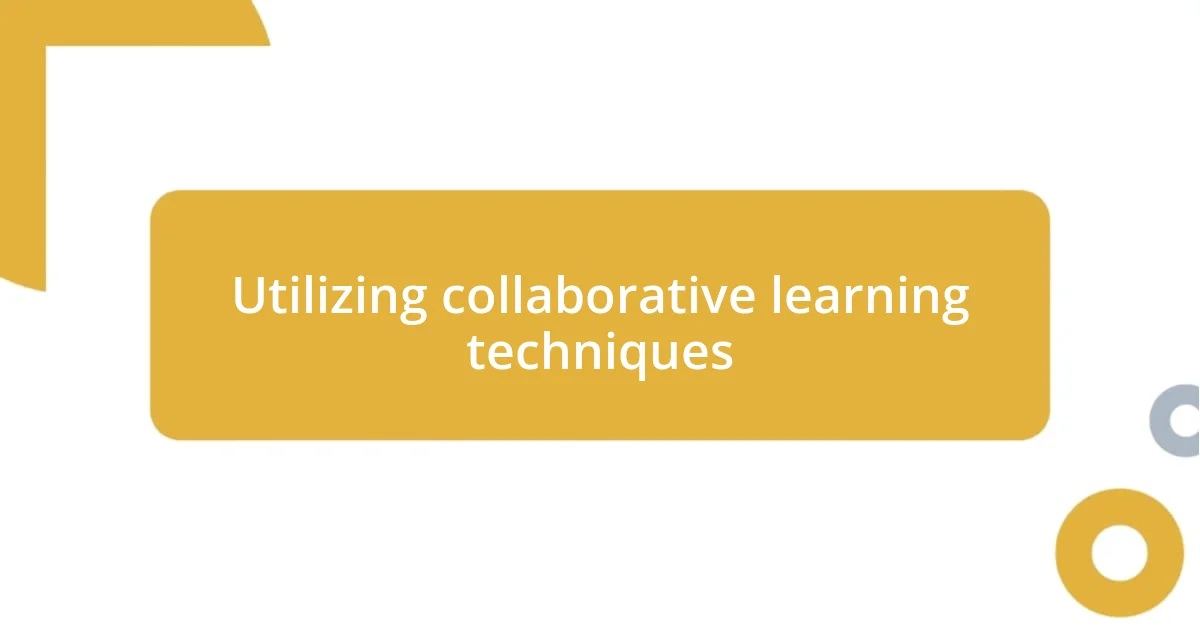
Utilizing collaborative learning techniques
Utilizing collaborative learning techniques can truly transform a classroom. When I’ve employed group projects, I’ve seen the magic that happens when students come together, each contributing their unique strengths. For example, in a recent science project, students working in teams not only divided tasks based on their interests but also excitedly exchanged ideas, leading to a deeper understanding of the subject matter. It’s fascinating how collaboration not only enriches their learning experience but also builds social skills.
One memorable instance was during a literature circle I organized last year. I noticed students who would usually shy away from participation stepping up to lead discussions. They felt safe sharing their perspectives because they were part of a supportive team. Have you ever felt how powerful it is when students engage meaningfully with one another? I certainly have, and it reinforced my commitment to fostering environments that thrive on collaboration.
Furthermore, implementing peer teaching strategies has been a game-changer for me. By allowing students to explain concepts to one another, they deepen their own understanding while fostering a sense of responsibility for their peers’ learning. I recall a moment when a student, who typically struggled, took the lead in a math lesson. The pride on their face as they helped others was indescribable. Isn’t it incredible how collaboration can empower students to step into roles they never imagined?
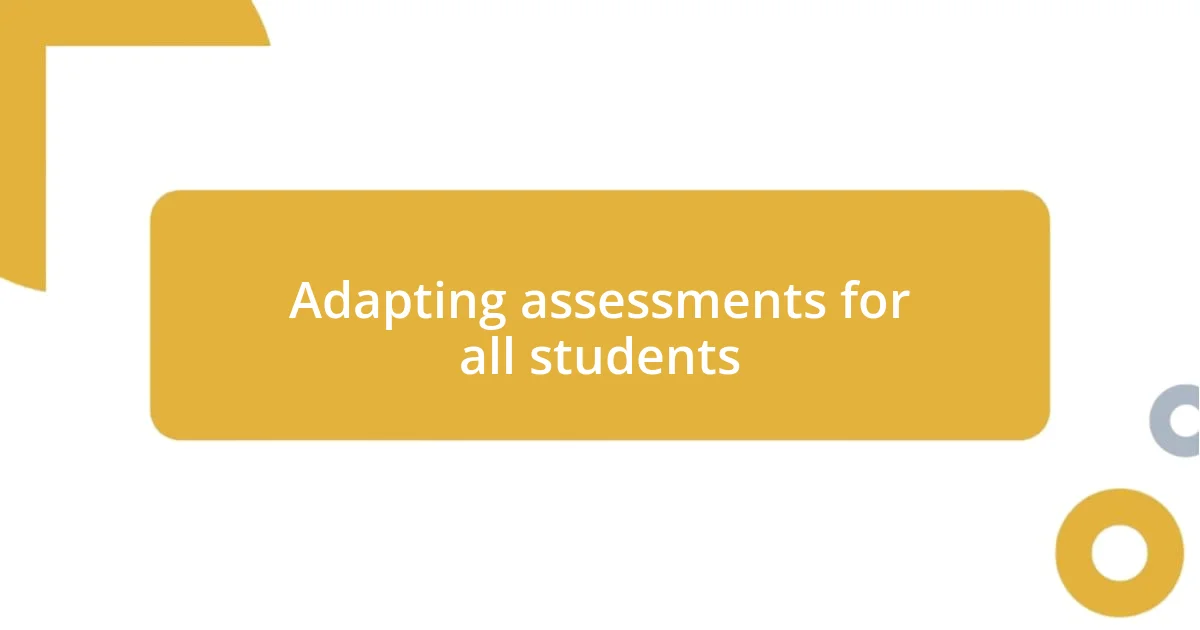
Adapting assessments for all students
Adapting assessments for all students is crucial in ensuring that each learner has the opportunity to demonstrate their understanding. I remember a time when I offered my students various ways to showcase their knowledge after a unit on ecosystems. Some opted for traditional essays, while others created vibrant poster presentations or even digital videos. Each format allowed their creative strengths to shine, and it was fascinating to see how different mediums could express the same level of comprehension.
I also find that modifying the assessment environment can make a significant difference. On one occasion, I noticed that a few students thrived in quieter settings, so I created a “calm corner” equipped with comfortable seating and minimal distractions for tests. Watching those students flourish in such an atmosphere confirmed my belief that sometimes, all it takes is a slight adjustment to help students reach their potential.
Moreover, I’ve learned the value of providing individualized support during assessments. For instance, I’ve integrated verbal assessments for students who may struggle with writing. This shift became a lightbulb moment for one particular student, who had always avoided tests. By giving them the chance to verbally express their understanding, I witnessed a newfound confidence. Isn’t it rewarding to see a student embrace their learning style and flourish?
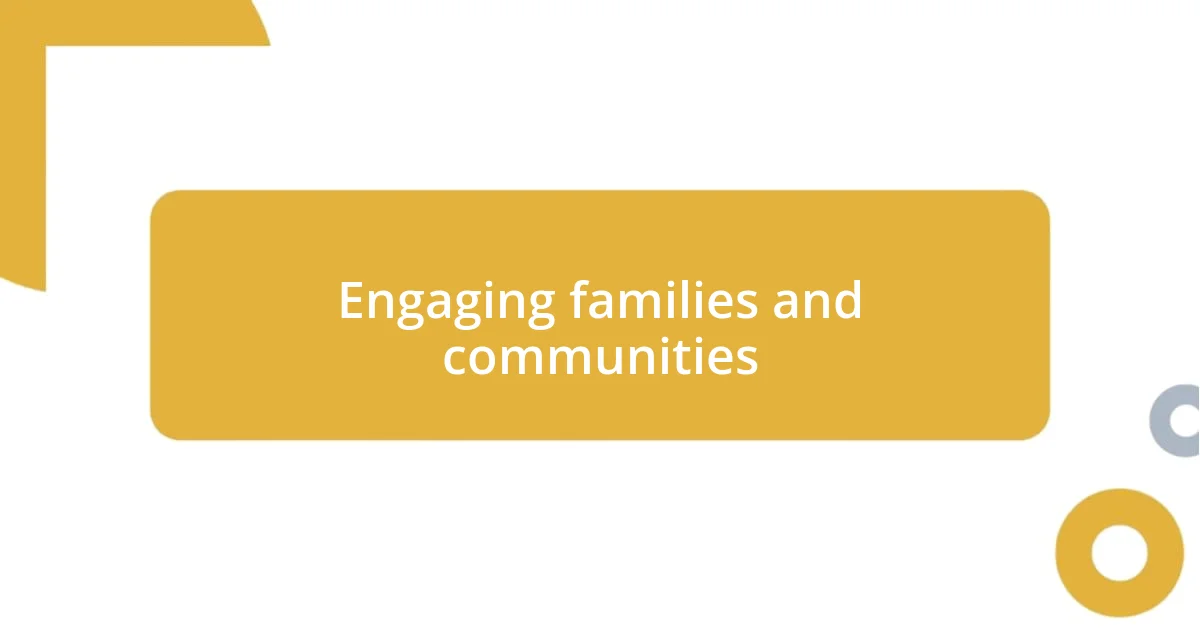
Engaging families and communities
Engaging families and communities has been one of the most enriching aspects of my teaching journey. I vividly remember the first time I invited parents to share in our classroom activities. One mother brought traditional recipes from her culture, and as students helped to prepare the dishes, it felt less like a lesson and more like a family gathering. It opened my eyes to the idea that learning extends beyond textbooks and fosters a sense of belonging.
Another effective strategy has been setting up regular community events, such as “family nights” where everyone can share their skills. I once organized an evening where families taught various crafts, and I nearly burst with pride watching students showcase their parents’ talents. These moments not only bridge gaps between home and school but also allow families to feel valued in the learning process. Have you ever witnessed the magic of families coming together? For me, it was a heartwarming reminder of the vital role community plays in education.
I’ve also learned the impact of open communication with families. Sending weekly updates about class activities and encouraging feedback has transformed how we interact. One parent opened up about their child’s unique learning challenges, and it led to tailored strategies that made a world of difference. This collaborative approach not only strengthens relationships but also creates an inclusive environment. It’s fascinating how engaging families can make a classroom feel like a united community, don’t you think?












